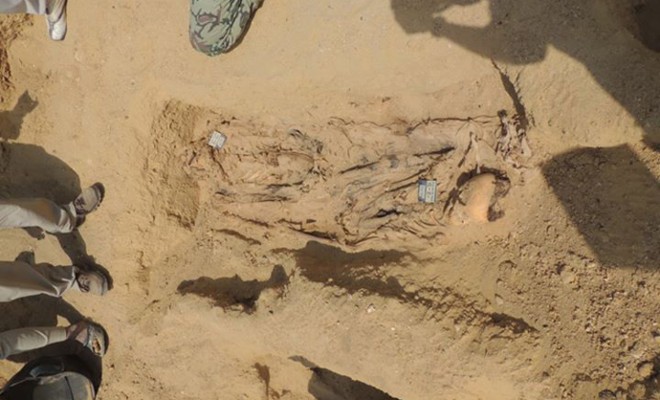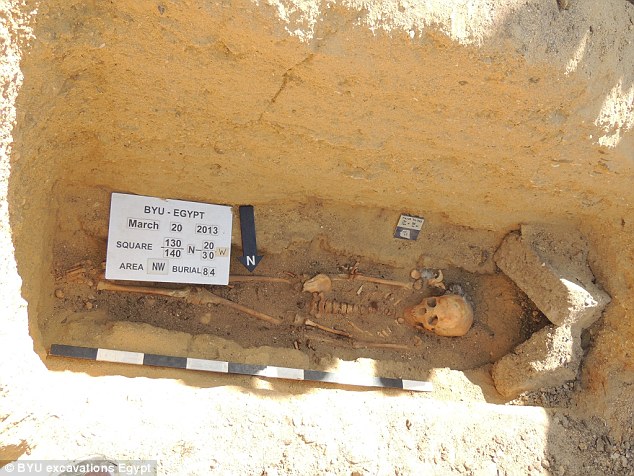Estimated 1M mummified bodies found in Egyptian necropolis, some 7ft tall
No explanation of where the bodies came from, scientists say
By Shepard Ambellas | Intellihub

FAIYUM, EGYPT (INTELLIHUB) — So far over 1,700 mummified bodies, of an estimated 1 million, have been unearthed in a necropolis South of Cairo.
It appears the mummies are approximately 1,500-years-old, buried during the time when Rome control vast swaths of Egypt.
However, the discovery has scientists scratching their heads as the literally have no explanation of where all of the bodies came from.
At least one body was reported to be more than 7ft. tall.
Kerry Muhlestein, the project director, from Brigham Young University, Utah, said for every 5 x 5 sq. meter sand plot excavated at least 40 bodies have found, showing the true significance of the site.
According to a recent report, the site named “Fag el-Gamous”, a necropolis, when translated means “The way of the buffalo”.
Interestingly most of the bodies were buried with no coffin. However key features of the bodies, like the brains, tongues and nails, seem to be well-preserved.
The mummies were also reported to have been separated into different burial sections based on their hair color.
Read more articles by this author here.
Cemetery with one MILLION mummies unearthed in Egypt: 1,500-year-old desert necropolis is the largest ever found
By Richard Gray | MailOnline

A cemetery containing more than a million mummified human bodies has been unearthed in central Egypt, according to archaeologists.
Scientists have already excavated more than 1,700 mummies, preserved by the hot dry desert in the Faiyum region of Egypt about 60 miles (96km) south of Cairo.
But those leading the work believe their could be up to a million similar bodies buried in shafts cut into the limestone rock that are at times up to 75ft (22.9 metres) deep.
(Many more photos here)
Video: Cemetery with one MILLION mummies unearthed in Egypt
Cemetery with one MILLION mummies unearthed in Egypt: 1,500-year-old desert necropolis is the largest ever found
A cemetery containing more than a million mummified human bodies has been unearthed in central Egypt, according to archaeologists.
Scientists have already excavated more than 1,700 mummies, preserved by the hot dry desert in the Faiyum region of Egypt about 60 miles (96km) south of Cairo.
But those leading the work believe their could be up to a million similar bodies buried in shafts cut into the limestone rock that are at times up to 75ft (22.9 metres) deep.
It is thought that the mummies were buried around 1,500 years ago, between the 1st and 7th Century AD, when Egypt was controlled by the Roman and Byzantine Empire.
Unlike many famous mummified remains discovered in Egypt, these were found in mass graves and appear to be ordinary citizens rather than royalty or other important figures.
Yet scientists are baffled about where the huge numbers of mummies came from – the remains of a nearby village is too small to warrant such a large cemetery and the nearest town, named Philadelphia after King Ptolemy II Phiadelphus, has its own burial sites.
Archaeologists have also uncovered a bizarre range of mummies, including one man who is more than seven feet (213 cm) tall.
They have also discovered that the mummies appear to be clustered together by hair colour, with those with blond hair in one area and all of those with red hair in another.
Professor Kerry Muhlestein, project director of the excavation at Brigham Young University, in Utah, said: ‘We are fairly certain we have over a million burials within this cemetery. It’s large, and it’s dense.’
Although the Fag el-Gamous necropolis, which is named after a nearby road that translates as ‘Way of the Buffalo’, was first discovered nearly 30 years ago, archaeologists are still trying to piece together what they have found there.
Annual excavations at the site, on the eastern edge of the Faiyum region, near the city of Silah, regularly unearth mummified remains and Professor Muhlestein presented the latest discoveries at the Scholars Colloquim at the Society for the Study of Egyptian Antiquities last month.
Among the recent discoveries made last year were the mummified remains of a little girl aged around 18 months old, still with two bracelets on each arm.
Unlike royal Egyptian mummies, the people buried at Fag el-Gamous had few goods buried with them and were laid in the ground without coffins.
Their internal organs were also rarely removed, an important part of the mummification process, so it is the arid environment of the desert that is largely thought to have preserved the bodies.
However, with the latest discovery of the little girl, Professor Muhlestein said there appears to have also been some attempt by those who buried her to use the full mummification process.
Writing on the team’s Facebook page, which Professor Muhlestein only recently updated in an attempt to keep the discoveries secret, said: ‘This mummy was beautifully wrapped in a tunic and with other nice wrappings.
‘There was some evidence that they tried much of the full mummification process. The toes and toenails and brain and tongue were amazingly preserved.
‘We found a wonderful necklace and two bracelets on each arm. The jewellery makes us think it was a girl, but we cannot tell.
‘She was buried with great care as someone who obviously loved her very much did all they could to take care of this little girl in burial. Very sad.
‘But they succeeded, it was a beautiful burial. She had been buried with several other mummies, so we are interested in examining them.’
Another woman, with long blonde hair, was found buried among a group of other bodies that all had healthy sets of teeth.
Professor Muhlestein said: ‘Quite a few of our mummies had excellent teeth, something that is unusual.
Much of the discoveries have yet to be properly published as the archaeologists have been reluctant to reveal the exact location of the cementery.
Professor Muhlestein described how one mummy was found folded in half in order to fit him into the burial shaft. He believes that the man, who was over 7ft tall (213cm) may have suffered from a medical condition caused by an excess of growth hormone, but said more research needs to be done to prove this.
He also believes that some of the clusters by hair colour may actually be due to people being buried in family groups and so are related.
He hopes that genetic testing may be possible to help show how some of the mummies were related to each other.
Together with the bodies, archaeologists have also discovered glass beads, linen, jewelry and even colourful children’s boots.
‘A lot of their wealth, as little as they had, was poured into these burials,’ said Professor Muhlestein.
